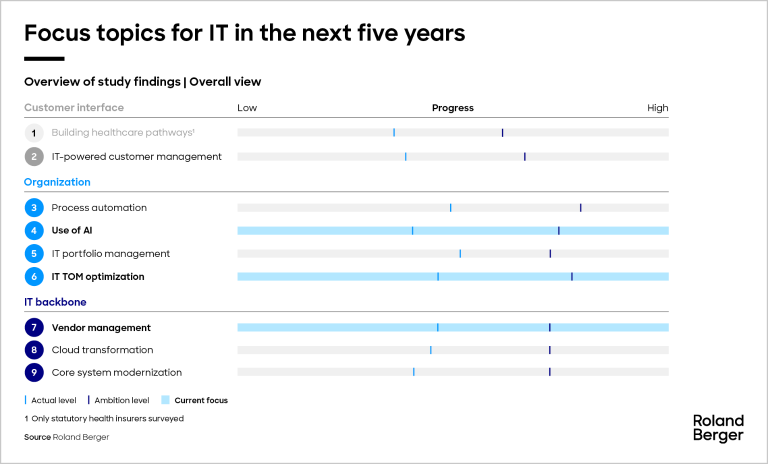Adapting to emerging risks and operational challenges.


How IT can cut costs for insurance companies: Digitalization with bottom-line impact
By Ulrich Kleipaß and Christian Schareck
Study reveals key approaches for adding business value
IT spending by insurance companies and statutory health insurers has risen six percent a year in the past two years alone. The impact on efficiency has been negligible to date. While numerous digital initiatives have been launched, many of these projects remain in the pilot stages – for the most part, however, they lack any sign of the much-anticipated efficiency gains in the core business. At the same time, the transformation pressure is ramping up as the value add and the benefit of the projects are being scrutinized ever more rigorously given the continuing rise in vendor costs, staffing costs and regulatory costs.
Against this backdrop, the authors of the recent "Digital 3.0" study examined the status quo in the insurance industry in Germany, Switzerland and Austria. Based on in-depth interviews with experts from across the IT and digitalization arena, an extensive literature review and an analysis of transformation projects, they reveal the most important areas where action should be taken to achieve a strong business impact, and they explain what aspects companies need to tackle to increase their digital maturity.
Most potential to be found in AI, vendor management and the IT TOM
One of the study's key findings is that IT spending is not set to fall for the foreseeable future. Indeed, the majority of surveyed experts anticipate a further increase in IT costs, with some even expecting these costs to rise more than eight percent. This only adds to the pressure to ensure all of the measures taken have an impact on the organization's bottom line.
The authors cite nine areas that can be leveraged for the greatest impact. These include process automation, IT portfolio management, cloud transformation and core system modernization.
The three biggest levers right now are greater use of artificial intelligence , good vendor management and optimization of the IT target operating model (TOM).
Governance, data infrastructure and cultural acceptance were found to be the key barriers to seamless integration. The handling of sensitive data (e.g. social data) also remains a challenge.
Currently, the biggest benefit of AI lies in applying it to well-defined use cases like document classification, fraud detection, claims handling and standard communications. But this requires a clean data strategy, transparent governance and a high quality of data. Insurers should therefore begin with targeted pilot projects in areas like operations, loss adjustment and underwriting. In parallel, they should build an organization-wide data strategy to guarantee transparent governance, clear responsibilities and semantic standards.

More than half of companies exhibit low digital maturity
Overall, the study makes it clear that insurance companies and health insurers have reached only a low level of maturity across the various digital channels. While one-third of the companies participating in the survey have clear ambitions to be a digital leader – which would give them a high level of digital maturity across almost all of the identified areas for action compared to industry peers – more than half of firms currently have modest ambitions and a low level of maturity in the relevant areas. Given how costs have developed over recent years, those insurers with a low level of maturity and a need for structural improvements should be asking themselves which areas are the most suitable for starting new projects and initiatives in their own context – but mainly, where the payoff would be greatest.
The study authors outline how to achieve the most progress in the different areas – even with limited resources – and how to quantify the value add of the various measures. That said, there is no sure formula for the overall process of optimization they describe. All efforts must be guided by the particular circumstances and capacities within the departments and in IT . For example, a motor vehicle insurer seeking to become innovation leader in their segment may focus on an agile TOM combined with a cloud-first approach, whereas the right solution for a commercial insurance firm could be to prioritize vendor management to reduce the cost of, say, implementation services, and to achieve efficiency gains in the portfolio.
One thing is for sure: Rolling back IT spending is not going to bring efficiency gains and cost reductions. What organizations need is efficient IT that they can leverage for successful business.
Register now to access the full study and explore "Digital 3.0". Furthermore, you get regular news and updates directly in your inbox.






_person_320.png?v=1034513)
_person_320.png?v=800903)


